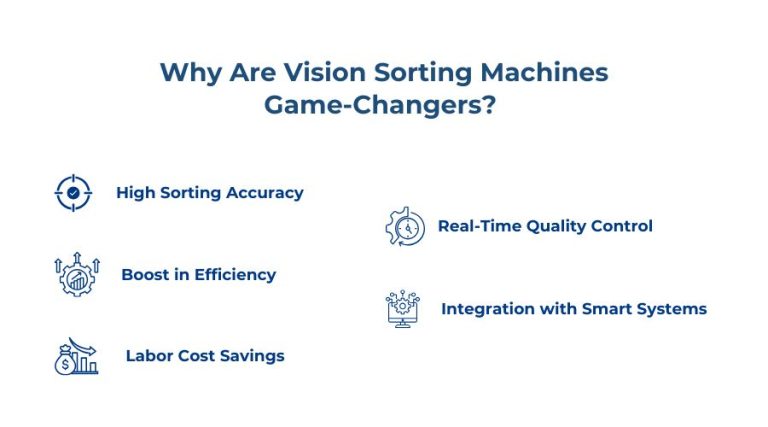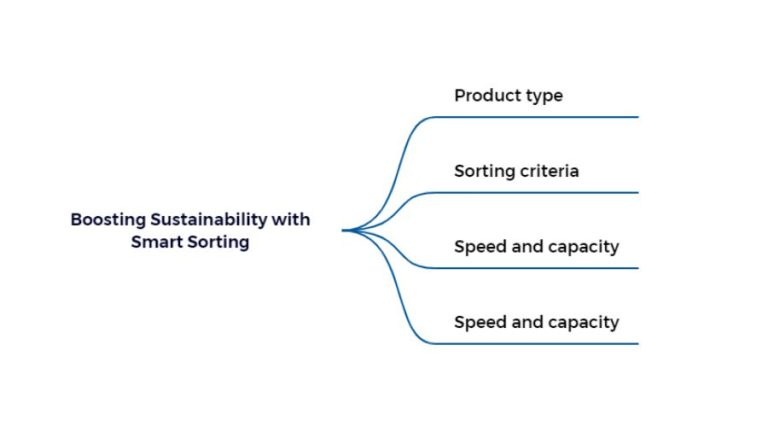Introduction
In today’s industrial landscape, which is evolving so rapidly, precision, speed, and reduction of wastage are of the highest priority. This intelligent solution is transforming the sort and inspection of products in a variety of industries. Whether you are involved in food processing, produce sorting, pharmaceuticals, or manufacturing, the use of optical sorting machines can completely transform your business model. They bring precision, efficiency, and consistency to production processes.
So, why are image sorting machines so effective? Why are they rapidly gaining popularity among industries? Let us discuss how these high-tech sorting machines help industries in more precise sorting, higher cost savings, and faster growth.
The Rise of Vision Sorting Technology
Vision sorting machines are powered by smart vision inspection systems. These systems use cameras, sensors, and AI to analyze the physical traits of products. Think of color, shape, size, and surface quality. Some advanced models even detect internal defects.
These systems have revolutionized the automated food sorting machine market. But they’re not limited to food alone. Industries from pharmaceuticals to electronics use camera vision inspection systems to ensure top product quality.
Imagine a tomato separator machine that can spot bruised tomatoes and remove them instantly. Or a fruit sorter that only selects ripened fruits. That’s the power of optical sorting machines with vision system cameras.

The technology behind vision sorting machines is both simple and sophisticated:
Image Capture – Cameras or vision system cameras take high-speed images of items.
Processing – AI software analyzes the images.
Sorting – Actuators remove items that don’t meet set standards.
This all happens in milliseconds. The machine can handle thousands of pieces per minute without losing accuracy.
Why Are Vision Sorting Machines Game-Changers?

Let’s break down the key benefits:
High Sorting Accuracy
Machine sorting using vision technology delivers unmatched accuracy. Traditional manual sorting is slow and prone to errors. In contrast, automated vision inspection systems can process thousands of items per minute.
That means fewer mistakes, higher consistency, and better output.
Speed matters. Vision sorting machines work non-stop and don’t get tired. This leads to faster throughput. Whether it’s fruits, nuts or vegetables, these systems sort with lightning speed.
They also reduce the need for rework. Faulty items are identified and removed early.
Labor Cost Savings
Hiring skilled labor for sorting is costly. Vision inspection systems reduce that need. You only need minimal supervision. That cuts operational costs without affecting quality.
Real-Time Quality Control
Vision inspection offers instant feedback. You know in real-time if a batch has issues. This means problems get solved quickly. No need to wait for end-of-line checks.
This is especially useful in the optical sorting machine sector for food and pharmaceuticals.
Integration with Smart Systems
Many vision system cameras integrate with factory automation software. You can track defects, analyze trends, and optimize processes—all from one dashboard.
This data helps companies refine their quality control and improve production.
Applications In Diverse Industries

Now let’s explore how different industries use vision sorting machines and vision inspection systems:
Food Industry
In the automated food sorting machine market, precision is everything. Whether you’re sorting tomatoes, nuts, or meat products, optical sorting machines help eliminate defective or contaminated items.
A tomato separator machine, for instance, ensures only ripe, unbruised tomatoes make it through. A fruit sorter identifies and removes underripe or spoiled fruits.
This leads to higher product quality, better shelf life, and reduced food waste.
Pharmaceutical Industry
Pill size, shape, and color must be consistent. Vision inspection systems ensure every tablet or capsule meets these standards.
Incorrect pills are rejected before reaching packaging. This ensures consumer safety and maintains brand trust.
Packaged Products
Micro-labels such as QR codes and barcodes need to be inspected using a camera vision inspection system. Defects such as label misalignment, sealed packaging, or damage on canned products can be detected immediately.
This prevents costly recalls and customer complaints.
Agriculture
In modern farming, vision system for quality inspection is gaining popularity. For example, nut sorting systems analyze each nut’s size and color. Only the healthiest nuts are provide for coustomers.
This improves crop yield and reduces input waste.
What to Consider Before Buying One
Not all optical sorting machines are equal. When choosing a vision sorting machine, consider:
Product type: Different machines sort different items. A fruit sorter may not work well for pills.
Sorting criteria: What defects do you want to detect? Color? Shape? Size? Surface damage?
Speed and capacity: How many items per minute can it handle?
Camera resolution: Higher resolution gives better defect detection.
Software support: Can it integrate with your current system?
Also, ask about after-sales support. Even the best machines need regular maintenance.
Boosting Sustainability with Smart Sorting

Waste reduction is a major industrial goal. With machine sorting powered by AI, industries can reduce material loss.
In food production, removing bad items early prevents entire batches from being wasted. In food processing, faulty food products are caught before being packaged, saving time and resources.
Vision inspection systems promote smarter use of materials. That’s good for business and the planet.
Future Trends in Vision Sorting Machines
The future looks promising. More industries are turning to automated vision inspection systems. Trends include:
Higher AI accuracy: Machines learn and improve with time.
Cloud-based monitoring: Remote control and diagnostics.
Miniaturization: Smaller devices for compact spaces.
Energy efficiency: Greener systems for sustainability.
As the automated food sorting machine market grows, expect machines that are faster, smarter, and easier to use.
Conclusion
Vision sorting machines are not just tools—they are game-changers. They help companies sort faster, reduce waste, and deliver better products. From the fruit sorter to the vision inspection system in electronics, these machines make quality control smarter and more efficient.
If you’re in an industry that relies on accuracy, speed, and consistency, investing in a vision sorting machine may be the smartest move you’ll make. The benefits are clear. The results are proven.
It’s time to let the machines do the sorting.
FAQs
Can a vision sorting machine detect internal defects?
Certain of the newer high-end optical sorting machines can detect internal defects, depending on the technology.
Is a vision inspection system easy to integrate with my current production line?
Yes. Most newer sorting systems are designed for easy integration with current production lines.
In what ways is a vision sorting machine different from a metal detector?
A metal detector will detect metallic impurities. A vision sorting machine inspects visual features like color, shape, and surface imperfections.






